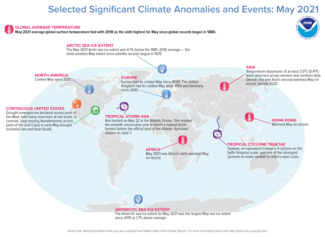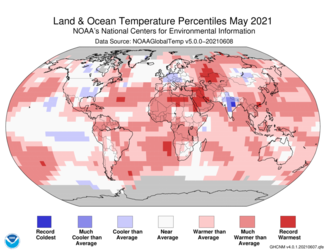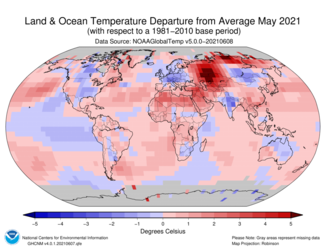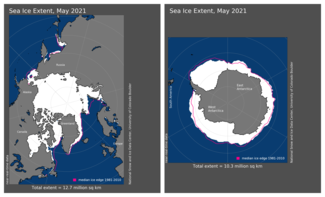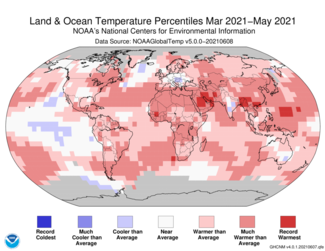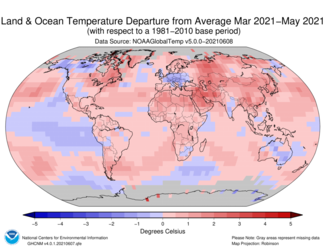Sixth-warmest May on record for the Globe; third-smallest Northern Hemisphere May snow cover extent on record

The global temperature for May 2021 tied with 2018 as the sixth highest for the month of May in the 142-year NOAA record, which dates back to 1880. The year-to-date (January-May) global surface temperature was the eighth highest on record. According to NCEI’s Global Annual Temperature Rankings Outlook, it is very likely that the year 2021 will rank among the 10 warmest years on record, with less than 2% chance for it to rank among the five warmest years on record.
This monthly summary, developed by scientists at NOAA’s National Centers for Environmental Information, is part of the suite of climate services NOAA provides to government, business, academia and the public to support informed decision-making.
Monthly Global Temperature
The May 2021 global surface temperature was 1.46°F (0.81°C) above the 20th-century average of 58.6°F (14.8°C), tying with 2018 as the sixth-warmest May in the 142-year record. May 2021 marked the 45th consecutive May and the 437th consecutive month with temperatures, at least nominally, above the 20th-century average.
Temperatures were much above average across parts of northern, western and southeastern Asia, Africa, northern South America and across parts of the Pacific, Atlantic, and the Indian Oceans. Temperatures were cooler than average across parts of North America, the eastern Pacific Ocean, central Europe, central Asia and India.
Regionally, Asia had its second-warmest May on record, behind May 2020. Africa had its sixth-warmest May on record. Meanwhile, Europe and North America had their coolest May since 2004 and 2011, respectively.
Sea Ice and Snow Cover
The Arctic sea ice loss was slower than average during the month of May. Overall, the Arctic sea ice extent averaged 4.89 million square miles in May 2021. This was 243,000 square miles -- equivalent to the size of the African country of Somalia -- below the 1981-2010 average and the ninth-smallest May extent in the 43-year record, according to an analysis by the National Snow and Ice Data Center (NSIDC) using data from NOAA and NASA.
The Antarctic sea ice extent during May 2021 was the largest for May since 2015 at 3.99 million square miles. During the month, sea ice grew at a slightly below-average pace. Below-average May sea ice extent was observed across the Weddell and Ross Seas.
According to data from NOAA and analyzed by the Rutgers Global Snow Lab, the Northern Hemisphere snow cover extent during May was 1.08 million square miles below average -- the third-smallest May extent on record. Only May 2010 and 2012 had a smaller snow cover extent. The North American snow cover extent was the 11th smallest on record, while Eurasia had its fifth-smallest May snow cover extent on record.
Seasonal Global Temperature
The March-May 2021 global surface temperature was 1.48°F (0.82°C) above the 20th-century average of 56.7°F (13.7°C) and the eighth warmest March-May period in the 142-year record.
The March-May period is defined as the Northern Hemisphere’s meteorological spring and the Southern Hemisphere’s meteorological autumn. The Northern Hemisphere spring 2021 was the sixth-warmest spring on record, while the Southern Hemisphere had its 11th-warmest autumn on record.
During the three-month period, temperatures were much above average across parts of North America, South America, Africa, and Asia as well as parts of the western Pacific Ocean, the Atlantic, and Indian Oceans. In contrast, parts of the North Atlantic, Europe, the eastern Pacific Ocean, India and southeastern Australia were cooler than average.
Regionally, Africa and Asia had their fifth- and seventh-warmest March-May on record, respectively. Meanwhile, Europe and South America had their coolest March-May period since 2013 and 2014, respectively.
For a more complete summary of climate conditions and events, see our May 2021 Global Climate Report.

